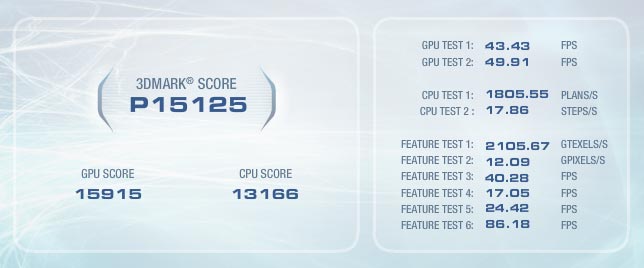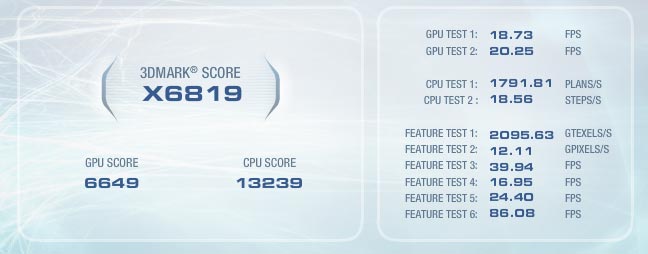3 - Some Vantage results
The results
We already stated it, we received the software really short prior to launch. So we'll focus on the stuff that matters the most to you guys, there's plenty more to be found in the software then this article covers though.
To run the entire test suite, just click on the Run Benchmark button in the Main tab of the 3DMark Vantage application. In the professional edition, this will run two graphics tests, two CPU tests, and six feature tests. The tests may take several minutes to run, depending on your system performance. When running the tests, do not touch the mouse or keyboard. Specifically, do not change the window focus away from the benchmark application. Doing so will abort the benchmark and invalidate the score.
The 3DMark Score is shown at the top left, prefixed with the letter code for the selected rendering option Preset (P for the Performance Preset in the example). Directly below the main 3DMark Score are the sub-scores: the GPU Score and the CPU Score. The right side of the results screen is taken up by the raw scores for each test.
The 3DMark Score and Sub-scores
The 3DMark Score represents the overall gaming performance of the tested system. Both the GPU and the CPU performance are reflected in the score. The GPU Score and CPU Score are called the sub-scores; they represent the performance of the GPU and CPU, respectively. The 3DMark® Score is formed by taking a weighted harmonic mean of the sub-scores. The GPU Score is formed by taking a weighted arithmetic mean of the raw scores of the two graphics tests. The CPU score is formed by taking a weighted arithmetic mean of the raw scores of the two CPU tests. The 3DMark Score is calculated slightly differently for each Preset. The higher Presets give a higher weight to the GPU Score. This means that the 3DMark Scores are not comparable across different Presets. Rather, they represent overall performance in a specific performance category defined by the Preset. For example, the Entry Preset scores represent performance at entry-level graphics load, and should not be compared with Performance, High or Extreme Preset scores. The sub-scores are comparable across presets, since they are calculated identically, regardless of the Preset. GPU Scores for the higher presets typically have lower values since the graphics load is significantly increased. CPU Scores are not affected by Presets, since the Preset rendering options only affect the graphics test.
Preset Scores
Each Preset gives an official 3DMark score. The scores are different for each Preset and not directly comparable across Presets. For example, running the test suite using the Entry preset yields an Entry 3DMark Score, denoted by the letter E pre-pended to the score reading.
Anyway, 3Dmark Vantage is all about the user-experience, go and try it out yourself. We already cooked up a few results. As stated earlier .. we have chosen to include two Vantage tests in all out future reviews. Guru3D will test in all their graphics benchmarks at standard at Performance and Extreme.
Here are the preliminary first results:

And obviously we also tested the software in a more extreme environment. We left the primary testing graphics card system and went for our (soon to be) high-end graphics card test platform based on nForce 790i SLI Ultra, 2 GB DDR3 memory @ 1800 MHz and to top it off for 3Dmark Vantage .. GeForce 9800 GX2 in Quad SLI :)

Above you can see that our scores just jumped in the default performance test.

But the Extreme test surely does not suck either. I have to say i very much like the implementation of a devided score. 3Dmark 05 & 06 had severe issues once the CPU became an issue. Very important for websites like Guru3D is that GPU score.
With that said, we're ending this article. Here are a couple of links you might find interesting:
- 3DMark Vantage Download (471MB)
- 3DMark Vantage Discussion thread
- 3DMark Vantage Guru3d Records thread
- 3DMark Vantage in Guru3D VGA Charts
Anyway, with that all said and done. The benchmark will ship in four editions:
- Trial (free)
- Basic ($6.95)
- Advanced ($19.95)
- Professional ($495)
You guys should try out the software for yourself. Mind you that you get one run for free, and to continue using 3DMark Vantage, you'll need to pay a (small) fee to FutureMark.
That's it, be sure to post your findings and experiences in our forums.
